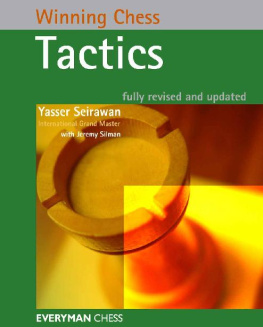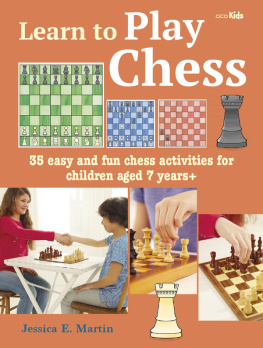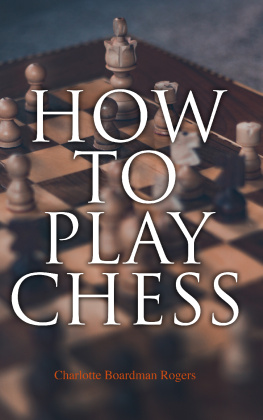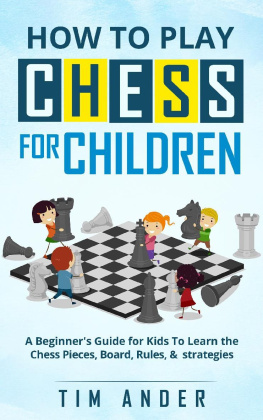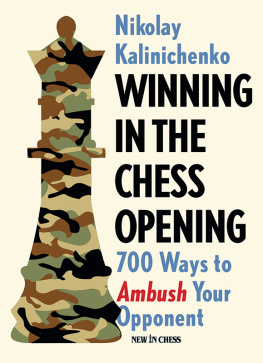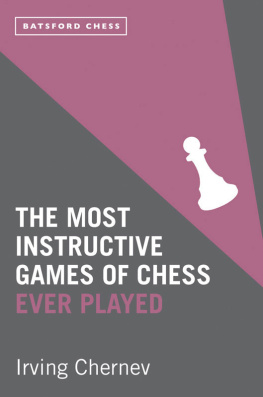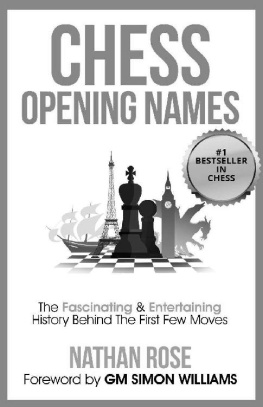Yasser Seirawan - Play Winning Chess
Here you can read online Yasser Seirawan - Play Winning Chess full text of the book (entire story) in english for free. Download pdf and epub, get meaning, cover and reviews about this ebook. year: 2012, publisher: Everyman Chess, genre: Children. Description of the work, (preface) as well as reviews are available. Best literature library LitArk.com created for fans of good reading and offers a wide selection of genres:
Romance novel
Science fiction
Adventure
Detective
Science
History
Home and family
Prose
Art
Politics
Computer
Non-fiction
Religion
Business
Children
Humor
Choose a favorite category and find really read worthwhile books. Enjoy immersion in the world of imagination, feel the emotions of the characters or learn something new for yourself, make an fascinating discovery.

- Book:Play Winning Chess
- Author:
- Publisher:Everyman Chess
- Genre:
- Year:2012
- Rating:3 / 5
- Favourites:Add to favourites
- Your mark:
- 60
- 1
- 2
- 3
- 4
- 5
Play Winning Chess: summary, description and annotation
We offer to read an annotation, description, summary or preface (depends on what the author of the book "Play Winning Chess" wrote himself). If you haven't found the necessary information about the book — write in the comments, we will try to find it.
Play Winning Chess — read online for free the complete book (whole text) full work
Below is the text of the book, divided by pages. System saving the place of the last page read, allows you to conveniently read the book "Play Winning Chess" online for free, without having to search again every time where you left off. Put a bookmark, and you can go to the page where you finished reading at any time.
Font size:
Interval:
Bookmark:

Published by Gloucester Publishers plc, formerly Everyman Publishers plc, Northburgh House, 10 Northburgh Street, London EClV OAT
Copyright 2003 Yasser Seirawan
Reprinted 2004 twice, 2005, 2006, 2007, 2009, 2010, 2011
All rights reserved. No part of the contents of this book may be reproduced, stored in a retrieval system or transmitted in any form or by any means, electronic, electrostatic, magnetic tape, photocopying, recording or otherwise, without prior permission of the publisher.
British Library Cataloguing-in-Publication Data
A catalogue record for this book is available from the British Library.
Print ISBN: 978 1 85744 331 8
ePUB ISBN 9781857448214
Kindle ISBN 9781857449068
Distributed in North America by The Globe Pequot Press, P.0 Box 480, 246 Goose Lane, Guilford, CT 06437-0480
All other sales enquiries should be directed to Everyman Chess, Northburgh House, 10 Northburgh Street, London EClV OAT
Tel: 020 7253 7887 Fax: 020 7490 3708
Email:
Website: www.everymanchess.com
Everyman is the registered trade mark of Random House Inc. and is used in this work under license from Random House Inc.
EVERYMAN CHESS SERIES
Chief Advisor: Byron Jacobs
Commissioning editor: John Emms
Cover Design: Horacio Monteverde
Printed and bound in the US
CHAPTER ONE
The Evolution of Chess
CHAPTER TWO
The First Principle: Force
CHAPTER THREE
The Second Principle: Time
CHAPTER FOUR
The Third Principle: Space
CHAPTER FIVE
The Fourth Principle: Pawn Structure
CHAPTER SIX
Annotated Games
CHAPTER SEVEN
The Four Principles and You
As a lifelong lover of books and all things chess, Ive often had the good fortune to pick up a book that has made my spirits soar. One such book is a first edition of Practical Chess Grammar, or An Introduction to the Royal Game of Chess by W.S. Kenny, which was published in London in 1818.
My motives for writing this book for beginning chess players are exactly the same as those expressed by Kenny in his book:
Of all pastimes, it has been generally allowed by all who have had least insight into the game, that Chess is the most noble, as well as most fascinating: Kings and warriors have studied it, the former to establish laws, and the latter to plan engagements in the field; the mathematician has diligently examined its positions, to discover the solution of problems; and writers on education have concurred in recommending the cultivation of this pleasing exercise of the mind: at the same time, many are deterred from acquiring a knowledge of the game, owing to a false idea that it requires so mathematical a genius as to be suitable only for a Newton or a Euclid. In order to remove this false impression, the author of the present work offers to the learners of this pleasing amusement an insight into the nature of the game of Chess....
How nice it is to know that the same understandings and misunderstandings existed then as they do now.
The purpose of this book is to invite you, dear reader, into the incredible world of chess. Did you know that most countries consider chess a sport? And that in the Soviet Union, chess is the most popular national pastime? The two largest sports associations in the world are the IOC (International Olympic Committee) and FIFA (Fdration Internationale de Footbal Associationhere, footbal refers to soccer). The third is the FIDE (Fdration Internationale des checs), the international chess federation.
Chess is played around the globe by millions of enthusiasts. Unlike other sports, chess is constant. Whether on the beaches of Brazil, beneath the Great Wall of China, or at a Texas barbecue, the game is played the samesame movements, same rules. Chess has a language of its own, and since I began playing chess, Ive made dozens of friends, communicating with them through the pieces and squares.
Because the necessary equipment is inexpensive, chess has been called the most democratic of games. It crosses many boundaries: race, class, caste, sex, culture, religion, and so on. It is played by people from all walks of life. And it is played by those who cant walk. My first teacher, David Chapman, was a paraplegic. Blind singer and pianist Ray Charles admits that chess is his passion. You dont have to be 7 feet tall, as quick as Carl Lewis, or as strong as Mike Tyson to play chess. All you have to do is think.
When most people learn to play chess, they usually memorize the movements of the pieces and then spend years pummeling away at each other with little rhyme and even less reason. Though I will show you how each piece leaps around, what its favorite foods are, and what it likes to do on holidays, the real purpose of this book is to teach you the four major principles of my Seirawan method: force, time, space, and pawn structure. Each is easy to understand and each is a weapon that will enable you to defeat most anyone you challenge to a game.
After a general introduction to the game of chess, I explain each of the four principles in its own chapter. But you will find much more in these pages. Annotated games illustrate each principle with examples, and entire games allow you to see how the principles fit together. I suggest that you read with a chessboard set up in front of you so that you can play through these examples and turn theory into immediate practice. For those of you who want to measure your progress, pop quizzes allow you to check your understanding of specific concepts, and tests at the end of the chapters give you experience in putting the concepts together. (Youll find answers to the quizzes and the tests at the end of the book.)
I want this book to be fun to read in addition to being instructive. For that reason, Ive included highlights of chess history and profiles of some of the interestingand quirky! people who have played major roles in the development of the game.
Throughout the book, I offer psychological hints on ways to approach both the game and your opponent. People who play chess are inexorably changed. Their powers of concentration, reasoning, and perception are all heightened. Because planning and purposefulness go hand in hand, people who play chess become more responsible and disciplined.
Let me be the first to congratulate you on buying this book. You obviously want to hone your thinking skills by learning to play chess. This book offers you an introduction to the game that will both entertain you and transform you into a veritable gladiator of the chessboard.
Yasser Seirawan
Seattle, Washington

W e know that chess existed in India at the beginning of the 7th century, and we have evidence that a form of chess existed in central Asia in the 1st century. Some people claim that the game might date back as far as the 15th century B.C. Nobody knows exactly how old chess is.
From India, chess quickly spread to Persia and thence to Arabia, where powerful rulers patronized good players in the same manner that European nobility would later patronize musicians and artists. Chess first came to Europe when the Moors conquered Spain in the 8th century. Within a century or two, chess was being played throughout Europe, including Russia, spread by either soldiers or traders.
Whereas the countries of East Asia adapted the rules of the game and the board to local customs, Europe adopted the Muslim form of chess and played it for six centuries without change. Then the game changed dramatically, turning chess from a stodgy game of slow advances into a game of lightning strikes and constant action. Youll learn more about this change when we talk about the way the Queen moves.
Next pageFont size:
Interval:
Bookmark:
Similar books «Play Winning Chess»
Look at similar books to Play Winning Chess. We have selected literature similar in name and meaning in the hope of providing readers with more options to find new, interesting, not yet read works.
Discussion, reviews of the book Play Winning Chess and just readers' own opinions. Leave your comments, write what you think about the work, its meaning or the main characters. Specify what exactly you liked and what you didn't like, and why you think so.

